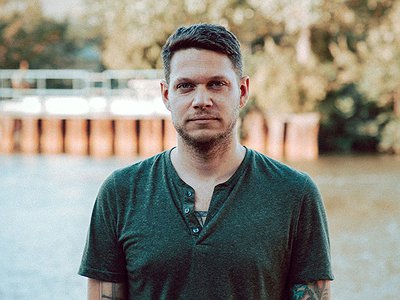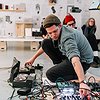Can you talk about a breakthrough work, event or performance in your career? Why does it feel special to you? When, why and how did you start working on it, what were some of the motivations and ideas behind it?
Four events (or moments) come to mind.
1. Performing at Pauline Oliveros’ Deep Listening Conference at EMPAC was a major milestone for me. But creating work for that specific environment and audience also gave me ideas as a performer and composer that I would’ve never accessed otherwise.
2. Performing at Cafe OTO in Dalston in a duo with Janek Schaefer was probably the most singularly unique and bizarre gigs of my life. He played (not through the house system, which is excellent, but) through 5 ghetto blaster stereos that he hardwired, except for that 2 didn’t work. And I did live tape loop splicing in front of a crowd. I’m talking: record, cut, tape, seal, and then use the loop to build collages from those sounds. All of my sounds were recorded that day/night at OTO and I gave all of them away to the audience at the end of the night.
3. Playing with the late, great film genius Paul Clipson every night for two weeks in Europe, the year before he passed away. Every day of that tour changed my life forever.
4. When my band Sontag Shogun got flown in to play the Frameworks Festival in Munich, which was probably the best sold out crowd we’ve ever performed for and also one of the scariest concerts because it was the first time we had to sub in a guest pianist for Ian, whose wife was giving birth. Miraculously, the show went perfectly, but it felt like walking a tightrope.
There are many descriptions of the ideal state of mind for being creative. What is it like for you? What supports this ideal state of mind and what are distractions? Are there strategies to enter into this state more easily?
I always talk about the importance of finding balance between praxis and poiesis (holla Aristotle!).
In exploring praxis, you’re working on your craft (ie: practicing) but that practice is also the point in and of itself. Like improvisation, repetition and cycling, doing the thing you do is an act that needs no other meaning beyond the moment.
Poiesis on the other hand, is a focus driven by the end result of that action. Conceptualizing one’s work as a part of a fixed timeline of activities that eventually culminate in a completed state, is just as important. We need both to truly make good on our creative dreams and concepts, and we need to make space for exploring both ways of working, or else the work will lack.
I am a lover of improvisation—dirty, energy-driven messes of spontaneous creativity—I am also a lover of pensive, well-executed symphonic work. In either circumstance, artists need to explore the mental states of both creative frameworks in order to achieve something profound.
Music and sounds can heal, but they can also hurt. Do you personally have experiences with either or both of these? Where do you personally see the biggest need and potential for music as a tool for healing?
To me when music or audio heals, it’s because either the work or the artist employs or communicates empathy. Sound is really nothing but air molecules shifting between an event and one or both of our eardrums. In this there’s a reminder that we’re all connected and attached to one another via microscopic, invisible particles; and yet those particles have an ability to make us feel joy or pain, make us remember the sound of our mother cooking, lift our senses, etc.
When empathy is the message in music or audio, the simplicity and profoundness of that message being sent through vibrating air cuts through our momentary struggles and suffering to communicate that “because you hear me, I hear you.”
There is a fine line between cultural exchange and appropriation. What are your thoughts on the limits of copying, using cultural signs and symbols and the cultural/social/gender specificity of art?
I think all art incorporates mimicry and theft to some degree. Attribution and credit is where this becomes okay economically, but when it comes to exchange and appropriation across cultures, all of a sudden power and marginalization comes into play.
It’s pretty cliché to say this but artists need to be careful and sensitive to borrowing ideas and artifacts from other cultures, because what may seem like paying homage to someone else’s traditions and history is probably also creating an “othering” effect, and may subtly remove the original symbolic source from any dialogue or conversation about its use. Mostly I think it’s always important for artists to make space for other voices and/or stakeholders that may tangentially be impacted by their work.
Our sense of hearing shares intriguing connections to other senses. From your experience, what are some of the most inspiring overlaps between different senses - and what do they tell us about the way our senses work?
I’m not sure I have a specific story that relates to multisensory overlaps as an experiential epiphany, but for anyone interested in artwork that utilizes the power of scent to tell stories and explore one’s own memory bank as well as collective and cultural reserves of nostalgia, politics, power, pain and joy, please look into the work of Norwegian artist Sissel Tolaas.
Tolaas’ work inspired my band Sontag Shogun to begin an evolving and longstanding collaboration with an artist who creates live scentscapes. As our music is tied strongly to memory and nostalgia, this partnership allowed us to create deeper connections with listeners beyond the music. And it was really fun and trippy too.
Art can be a purpose in its own right, but it can also directly feed back into everyday life, take on a social and political role and lead to more engagement. Can you describe your approach to art and being an artist?
My approach to art-making is really mostly for me only. I approach recording as a way of documentation—documenting and archiving my process as it evolves across eras—and I approach performance almost as an opportunity to practice my work, learn while doing, and get feedback from audiences who share in the moment. In this way I tend to gravitate toward other artists who do the same, who make music to satisfy their own curiosities and follow their own threads of creativity, and who don’t try to guess what their audience wants or expects to hear.
So for me, making creative work is very much an individual pursuit (Marcel Duchamp would famously disagree), and I view my role in the community to be based almost entirely on supporting others in what they do. I think it’s really important that musicians buy each other’s albums, attend each other’s gigs, shout out good work versus acting competitively, and contribute collectively with intentions that pan out wider than how much they’ll earn in exchange.
One thing I talk about all the time with other musicians is how much I think playing and writing music prepares people to become better citizens and community members, by virtue of the fact that music can only work when we’re listening to others and making space for others to share the same time and space we occupy. That said, society’s ills at large do often play out intersocially within musical communities, like if you’re a dominant personality your overt actions may impact other musicians in a band or ensemble, and likewise if you feel inferior or lack confidence, you may be taken advantage of artistically. Bands and musical groups can be these curious little microcosms of society in interesting ways. But that’s neither here nor there.
What can music express about life and death which words alone may not?
For those who have studied the Zen Buddhist concept of wabi sabi—the notion that every moment of bloom and blossom is also simultaneously on the spectrum towards decay and disappearance—I think it’s pretty beautiful to acknowledge audio as a metaphor for the existence of both states.
Every individual auditory event has an attack (when it becomes audible and thus enters existence) and a decay (a trail leading back towards silence). So writ larger, every total work of art communicates both life and death by virtue of its manifestation, and every note within that work functions both as an announcement of the vibrant flourishing of life and a submission to the eventual overtaking of silence and resolution.



